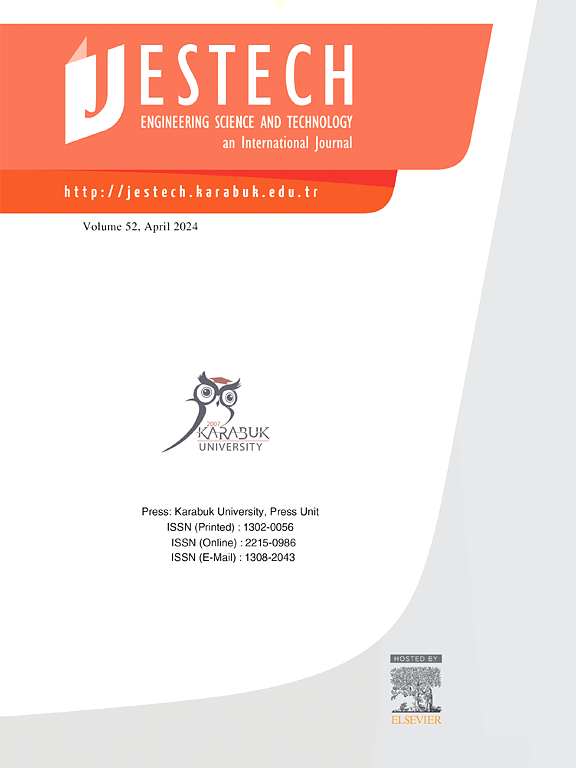Hybrid photovoltaic and thermoelectric generator systems with thermal wheel Ventilation: A sustainable approach to residential heating and cooling
IF 5.1
2区 工程技术
Q1 ENGINEERING, MULTIDISCIPLINARY
Engineering Science and Technology-An International Journal-Jestech
Pub Date : 2025-02-01
DOI:10.1016/j.jestch.2025.101968
引用次数: 0
Abstract
The growing need for sustainable energy solutions in residential buildings has driven research into renewable energy integration. While photovoltaic (PV) systems are well-explored, the combination of PV with thermal wheel (TW) systems and thermoelectric generator (TEG) units in thermoelectric ventilation (TEV) systems remains less studied. This paper investigates a hybrid system combining a concentrating PV (CPV)-TEG and a TW-TEV system for residential heating and cooling. Using energy and exergy analysis, two performance indicators, the Energy Proficiency Indicator (PIen) and the Exergy Proficiency Indicator (PIex), were introduced and calculated for a building in Jingzhou, Hubei, China. Results revealed peak PIen and PIex values of 2.44 and 33.55 in September and April, respectively. Additionally, increasing the number of thermoelectric coolers from 10 to 50 enhanced average yearly PIen and PIex by 60.45% and 81.32%. This study’s findings are significant for urban planners and engineers aiming to reduce energy consumption and emissions, offering a practical approach to sustainable building technologies.
带有热轮通风的混合光伏和热电发电机系统:一种可持续的住宅供暖和制冷方法
住宅建筑对可持续能源解决方案日益增长的需求推动了对可再生能源整合的研究。虽然光伏(PV)系统已经得到了很好的探索,但在热电通风(TEV)系统中,光伏与热轮(TW)系统和热电发电机(TEG)单元的组合研究仍然很少。本文研究了聚光PV (CPV)-TEG和TW-TEV混合系统在住宅供暖和制冷中的应用。采用能源和火用分析的方法,对湖北荆州某建筑引入了能源熟练度指标(energy Proficiency Indicator, PIen)和火用熟练度指标(exergy Proficiency Indicator, PIex)两个性能指标,并对其进行了计算。结果显示,PIen峰值为2.44,pix峰值为33.55,分别出现在9月和4月。此外,将热电冷却器的数量从10台增加到50台,可使年平均PIen和pix分别提高60.45%和81.32%。这项研究的发现对旨在减少能源消耗和排放的城市规划者和工程师具有重要意义,为可持续建筑技术提供了实用的方法。
本文章由计算机程序翻译,如有差异,请以英文原文为准。
求助全文
约1分钟内获得全文
求助全文
来源期刊

Engineering Science and Technology-An International Journal-Jestech
Materials Science-Electronic, Optical and Magnetic Materials
CiteScore
11.20
自引率
3.50%
发文量
153
审稿时长
22 days
期刊介绍:
Engineering Science and Technology, an International Journal (JESTECH) (formerly Technology), a peer-reviewed quarterly engineering journal, publishes both theoretical and experimental high quality papers of permanent interest, not previously published in journals, in the field of engineering and applied science which aims to promote the theory and practice of technology and engineering. In addition to peer-reviewed original research papers, the Editorial Board welcomes original research reports, state-of-the-art reviews and communications in the broadly defined field of engineering science and technology.
The scope of JESTECH includes a wide spectrum of subjects including:
-Electrical/Electronics and Computer Engineering (Biomedical Engineering and Instrumentation; Coding, Cryptography, and Information Protection; Communications, Networks, Mobile Computing and Distributed Systems; Compilers and Operating Systems; Computer Architecture, Parallel Processing, and Dependability; Computer Vision and Robotics; Control Theory; Electromagnetic Waves, Microwave Techniques and Antennas; Embedded Systems; Integrated Circuits, VLSI Design, Testing, and CAD; Microelectromechanical Systems; Microelectronics, and Electronic Devices and Circuits; Power, Energy and Energy Conversion Systems; Signal, Image, and Speech Processing)
-Mechanical and Civil Engineering (Automotive Technologies; Biomechanics; Construction Materials; Design and Manufacturing; Dynamics and Control; Energy Generation, Utilization, Conversion, and Storage; Fluid Mechanics and Hydraulics; Heat and Mass Transfer; Micro-Nano Sciences; Renewable and Sustainable Energy Technologies; Robotics and Mechatronics; Solid Mechanics and Structure; Thermal Sciences)
-Metallurgical and Materials Engineering (Advanced Materials Science; Biomaterials; Ceramic and Inorgnanic Materials; Electronic-Magnetic Materials; Energy and Environment; Materials Characterizastion; Metallurgy; Polymers and Nanocomposites)
 求助内容:
求助内容: 应助结果提醒方式:
应助结果提醒方式:


